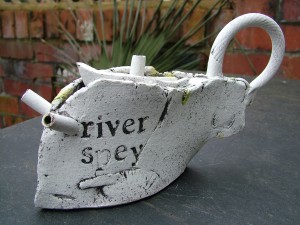
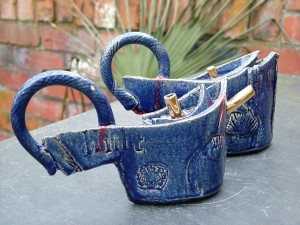
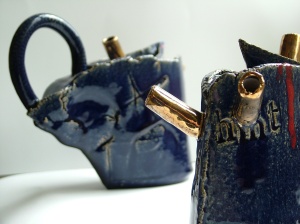 My pots often emerge from something happening around me. I like to start with a narrative or an experience. The Trawler series of teapots been in 2009 when my aunt rediscovered some letters and souvenirs from her childhood in the 1940s. She had been the mascot of a fishing boat that had been commandeered by the Royal Navy at the start of World War II for use as a minelayer/patrol boat in the North Sea. My grandparents lived in Norwich and the trawlers were working out of Lowestoft. She and my mother had knitted mittens for the crew and received letters and keepsakes from them. Rediscovering the story recently, it set us all off and we started digging. The trawler was called the River Spey and had been built by the Admiralty in 1918. The Navy had commandeered fishing boats in that World War I too and with so many being lost had begun a programme of building their own. They were fitted with guns and minelaying equipment but were otherwise normal trawlers that could be stripped of their armaments and sold off at the end of hostilities. Unhappy with calling them HMS this or that they were christened His Majesty’s Trawlers – HMT. Their names were also a problem. They could not be named after captains or admirals after all! Instead they chose to use the names of members of the crew of HMS Victory and HMS Royal Sovereign at the Battle of Trafalgar. River Spey started life as HMT David Conn, named after a 24 year-old ‘landsman’ on the Victory. She never saw military service and her later name was given by the fishermen who bought her from the Navy in 1919.
My pots often emerge from something happening around me. I like to start with a narrative or an experience. The Trawler series of teapots been in 2009 when my aunt rediscovered some letters and souvenirs from her childhood in the 1940s. She had been the mascot of a fishing boat that had been commandeered by the Royal Navy at the start of World War II for use as a minelayer/patrol boat in the North Sea. My grandparents lived in Norwich and the trawlers were working out of Lowestoft. She and my mother had knitted mittens for the crew and received letters and keepsakes from them. Rediscovering the story recently, it set us all off and we started digging. The trawler was called the River Spey and had been built by the Admiralty in 1918. The Navy had commandeered fishing boats in that World War I too and with so many being lost had begun a programme of building their own. They were fitted with guns and minelaying equipment but were otherwise normal trawlers that could be stripped of their armaments and sold off at the end of hostilities. Unhappy with calling them HMS this or that they were christened His Majesty’s Trawlers – HMT. Their names were also a problem. They could not be named after captains or admirals after all! Instead they chose to use the names of members of the crew of HMS Victory and HMS Royal Sovereign at the Battle of Trafalgar. River Spey started life as HMT David Conn, named after a 24 year-old ‘landsman’ on the Victory. She never saw military service and her later name was given by the fishermen who bought her from the Navy in 1919.
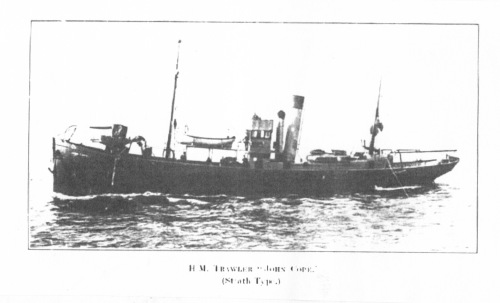
HM Trawler John Cope sister to the David Conn in its admiralty form with the 3pdr gun and its mounting clearly visible at the bow. (Photo from Admiralty Trawlers and Drifters, 1916-1921, DNC Admiralty, 1922. http://www.gwpda.org/naval/atrawler.htm.)
In World War II trawlers were again called up for naval duties. In 1940 River Spey was rearmed and fitted out as a minesweeper and became HMT River Spey. She served in the North Sea on anti-submarine duties with the Royal Naval Patrol Service throughout and survived to be returned to the fishing fleet afterwards. Her crew varied over time and some moved on to other services. Some time in 1940-41, they sent my mother a seaman’s uniform collar as a gift with their names written inside.
‘HMT River Spey to Joan with best wishes. Skipper Rose. Coxwain Jackson. Eng. McEune. Eng. Johnstone. L/S MacDonald. Sea. MacLeod. Sea/ Rea. Sea/ Greathead. Sea/ Squires. S/Cook Hume. S/ST Quinn. O/S Chatburn. O/S Booth. O/S Wood. Sea McCoy. Stoker Walsh. Stoker Butler. Stoker Phipps.’ Charles Rose RNR was skipper from May 1940 – Oct 1941 (see uboat.net)

Undated photo of HMT River Spey. 1941-45. The projection on the bow is a device for detonating acoustic mines. Imperial War Museum © IWM (FL12374).
There is no detailed record of her experiences but one story is distinctly out of the ordinary. RAF Wing Commander Roy Elliott was a specialist pilot flying unarmed aircraft on photographic missions and later Pathfinders who went ahead to mark targets with flares for bombing raids. His obituary (Daily Telegraph, 13 December 2001) contains the following:
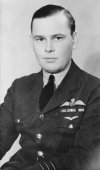
Wing Commander Roy Elliott DSO
‘On one occasion, after raiding Bremen in north Germany in a Vickers Wellington of No 3 Photographic Unit (No 3PRU) on the night of April 16-17 1941, one of the aircraft’s engines caught fire and shed a propeller. On the way home the aircraft lost so much height that Elliott was forced to ditch in the North Sea nine miles east of Lowestoft on the Suffolk coast. Unfortunately, the Wellington’s dinghy had been damaged during release and was barely able to accommodate the crew of six. It did not help that Elliott was carrying an extra cameraman and RCAF scientist. As a result two crewman had to hang on to the dinghy in the sea. The eight men were eventually picked up by the trawler River Spey and put ashore at Lowestoft. ‘
Managing to crash into the sea and stay afloat long enough to get the crew into a dinghy is pretty remarkable. To be found quickly and lose no one is more so.
Although Elliott was awarded a DSO, the crash and rescue is not documented in the official records nor is there any mention of it is my mother or my aunt’s letters from the crew. In practice combat aircraft losses were recorded – the reconnaissance aircraft were not. I have picked up one reference to Elliott and his men and the River Spey in a wartime diary – met celebrating in a Cambridge pub two days later! The writer recalled them talking about being rescued by ‘SS River Spee’. Elliott soon after moved to 83 Pathfinder Squadron at Scampton where he christened his new Avro Lancaster (OL-E P5669) ‘HMT River Spey’ in honour of the trawler that saved his and his crew’s lives. I would love to know what the nose-art looked like. The Lancaster HMT River Spey was later damaged in a crash-landing at Scampton, repaired, and reallocated to another squadron. She was shot down over Berlin in 1943. The trawler HMT River Spey returned to the fishing fleet in 1945 and sailed from Aberdeen and later Milford Haven where she sank at her moorings alongside the fish market on 16 Jan 1955.

River Spey sank at her moorings in Milford Haven in 1955. (John Stevenson Collection)
It is quite a story. Various things recur but particularly the need to record, remember and celebrate. David Conn and the crew of the Victory; the need for a mascot for the trawler; the letters and autographs sent to my Aunt; the photographic expedition; the celebration in the pub in Cambridge and the naming of the plane each represent points at which this happened. You can of course draw out other things and the story of the wartime trawler fleet in the North Sea is a grim one (e.g. Paul Lund and Harry Ludlam, 1971, Trawlers at War, London: Foulsham). A teapot to celebrate the story does not seem inappropriate though. Below are some of my drawings as I worked towards a design for a teapot to celebrate the River Spey. The form is strong especially with the overhanging stern contrasting against the very upright bow. I wanted an active striding shape rather than a ‘waterline’ static one. I work quickly and I prefer to minimise handling of the clay so as the preserve the freshness of line and surface. A single funnel provides a lid location But I’m not too concerned with the deck detail. A tubular spout seemed right – gun-like but not too much so. The handle was much more of a problem. The high rope/coil works well with the stern.
These drawings are mostly about form. The texture, surface and lettering happen at the clay stage. I often impress things into the clay slabs before I start making. Having started with a slab, if it is damaged or misshapen I will repair it with scraps. I try to avoid waste. The marks on the sides of the pots include impressions of a dolphin vertebra that I found on a beach in the Orkneys and the impressed lettering has the same sense of an aged, used, repaired, maintained thing rather than something pristine and anodyne. Whether to glaze or not to glaze has always been an issue. Drawing in Newlyn Harbour and looking at the fishing boats being repaired, there is always a strong contrast between brightly coloured paint and plastics against rusty steel, concrete and decaying ropes. 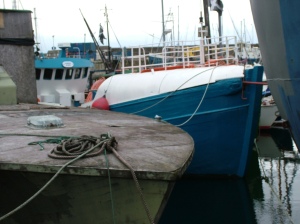

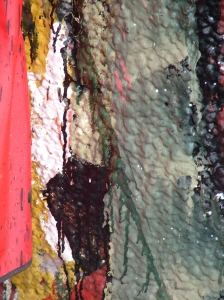
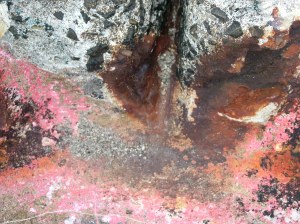
One day last year some of the students asked me about the trawler teapots. A day or two later one of them came up to me in the corridor and told me that her great-grandfather had been killed serving on a Royal Naval Patrol Service trawler during the Second World War. She had asked her grandfather about it and had the trawler’s name HMT De Rosa. De Rosa’s story is equally worth telling – but that’s another project (see Trawler Teapots – The Other Story).


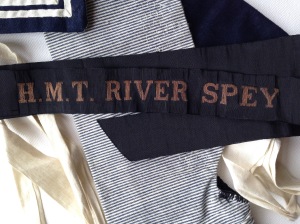
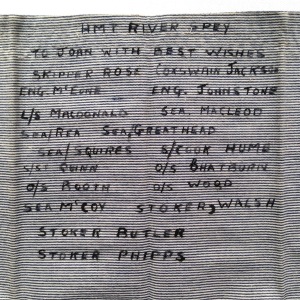
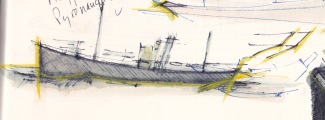
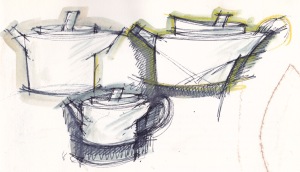
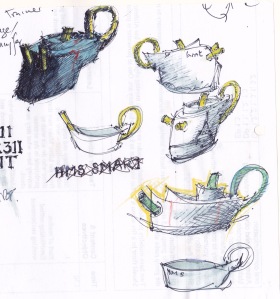
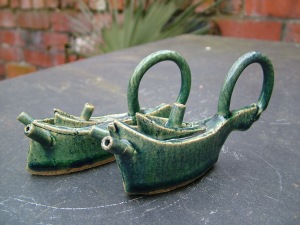
Please do tell the story of HMT De Rosa! My husband’s uncle was a crew member and would really be interested in finding out more. Thank you for this fascinating post and well done with all your research.
Best wishes, Vanessa
LikeLike
Hi Vanessa. I’m glad you found it interesting. It reminds me I should talk to my Mum about it again and write down a bit more of what she remembers. It’s tempting to write something about the De Rosa. I’ve got a collection of notes – not loads. I am not currently in contact with the student whose relative was a member of the crew but I could try and get in touch again.
LikeLike
Please do be tempted! I have some oral recordings from my husband’s aunt in which she talks about being invited on-board the De Rosa to meet up with a quiet 18 year old sailor. He became her future husband and I’d like to find out more.
LikeLiked by 1 person
Hi Vanessa. I have put together a new post which I hope you will find interesting. If there is anything you feel you can add please get in touch.
LikeLike
Reblogged this on Clay and Fire and commented:
I am reblogging this for various reasons but most of all because I have been able to add a photograph of a sailor’s collar given to my mother by the crew of the River Spey (probably in 1941), inscribed inside with their names.
LikeLike
Pingback: TRAWLER TEAPOTS – the other story. HMT DE ROSA | Clay and Fire